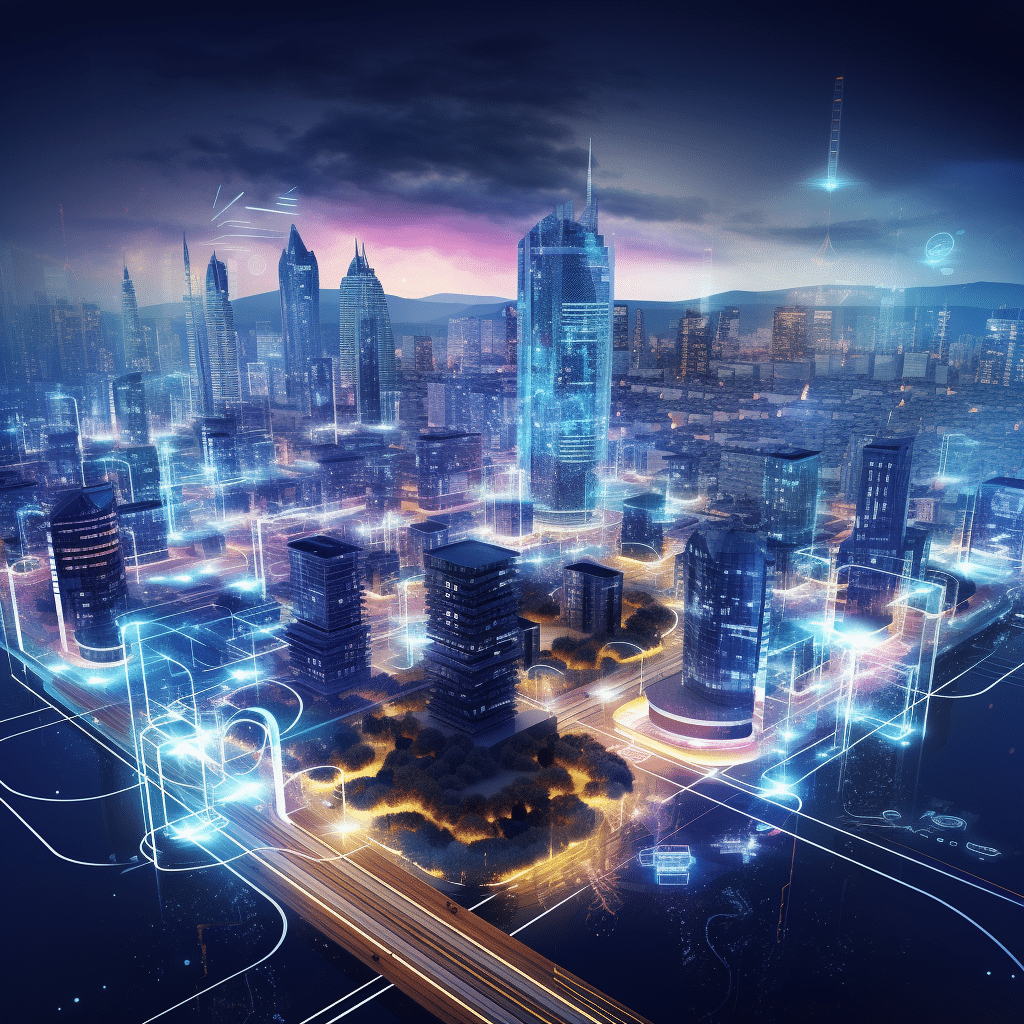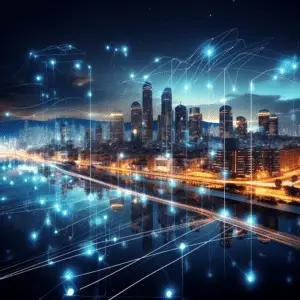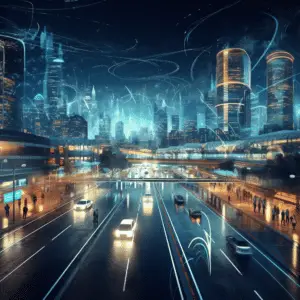
AI and Smart Cities: Paving the Way to Urban Sustainability

The rapid advancement of artificial intelligence (AI) technology is revolutionizing various industries, and one of the most notable areas of its application is in the development of smart cities. As urbanization continues to increase, concerns about sustainability, efficiency, and the well-being of citizens become paramount. Smart cities, powered by AI, offer innovative solutions to tackle these challenges and pave the way towards urban sustainability.

What is a Smart City?
A smart city is an urban area that harnesses technology, particularly AI, to improve infrastructure, enhance sustainability, and optimize various services. It leverages data and connectivity to streamline operations, improve resource management, and enhance the overall quality of life for its residents.
AI Enhancing Urban Sustainability
AI plays a crucial role in enabling smart cities to become sustainable ecosystems. By analyzing vast amounts of data collected from sensors, devices, and infrastructure, AI algorithms can provide valuable insights into energy consumption, traffic patterns, waste management, and other critical aspects of urban life. This information enables city planners and policymakers to make informed decisions and implement effective strategies to reduce energy and resource consumption, optimize transportation routes, and minimize environmental impact.

Efficient Resource Management
A key aspect of urban sustainability is efficient resource management. AI-powered systems can monitor and control energy usage in buildings and public spaces, automatically adjusting lighting and temperature settings based on occupancy and environmental factors. Intelligent waste management systems optimize garbage collection routes, reducing fuel consumption and greenhouse gas emissions. These AI-driven solutions not only improve environmental sustainability but also result in cost savings for the city and its residents.
Intelligent Transportation and Mobility
AI algorithms can revolutionize transportation systems and enhance mobility within smart cities. Through real-time data analysis, AI can identify traffic congestion and offer alternative routes to reduce travel times and alleviate congestion hotspots. AI-powered public transport systems can improve route planning, optimize vehicle dispatching, and enhance passenger experiences. Autonomous vehicles, guided by AI, can navigate and coordinate with each other, leading to safer and more efficient transportation networks. This integration of AI into transport systems paves the way for reduced traffic, improved air quality, and enhanced urban mobility for all.
Improved Quality of Life
A smart city strives to enhance the quality of life for its residents. AI plays a vital role in achieving this by enabling personalized services and enhancing public safety. Smart sensors and AI-powered analytics can monitor air quality, detect noise pollution, and identify potential safety hazards. With this information, city authorities can take prompt action to address concerns, ensuring a healthier environment for citizens. AI-powered healthcare systems can provide personalized diagnoses and treatments, improving the efficiency and accessibility of healthcare services. Additionally, AI algorithms can optimize the allocation of resources in education, public safety, and social services to meet the unique needs of the population.
Challenges and Considerations
While the prospects of AI and smart cities are promising, there are significant challenges and considerations that need to be addressed. Privacy and data security are critical concerns, as the collection and analysis of immense amounts of data raise privacy risks. An ethical and transparent approach to data governance is essential to ensure citizen trust and protection. Additionally, the digital divide must be bridged to ensure equitable access to technology and services for all residents. Finally, the integration of AI into existing urban systems requires robust planning, coordination, and collaboration between public and private entities.

Conclusion
The convergence of AI and smart cities has the potential to revolutionize urban sustainability. Through enhanced resource management, efficient transportation systems, and improved quality of life for residents, AI-powered smart cities can address the challenges of urbanization, while minimizing their environmental impact. However, it is crucial to address privacy concerns, ensure equitable access to technology, and foster effective collaboration among stakeholders to maximize the benefits of AI in smart cities. By embracing AI, we can create sustainable cities that thrive economically, socially, and environmentally, shaping a brighter future for urban living.
What are some key examples of AI applications that have successfully contributed to urban sustainability in smart cities?
There are several key examples of AI applications that have successfully contributed to urban sustainability in smart cities. Some of these include:
1. Intelligent Transportation Systems: AI-powered traffic management systems help optimize traffic flow, reduce congestion, and minimize carbon emissions by analyzing real-time data from sensors, cameras, and GPS devices. These systems can also predict traffic patterns and accidents to improve road safety.
2. Energy Management: AI algorithms can optimize energy consumption in buildings by analyzing data from smart meters, weather forecasts, and occupancy patterns. This helps reduce energy waste, lower utility costs, and minimize the environmental impact of buildings.
3. Waste Management: AI-powered waste management systems use sensors and cameras to monitor trash levels in bins and optimize waste collection routes. This reduces fuel consumption, improves efficiency, and lowers operational costs for waste management authorities.
4. Smart Grids: AI algorithms enable smart grids to balance energy demand and supply in real-time. By analyzing data from various sources, including weather forecasts and consumer behavior, AI can optimize energy distribution, reduce transmission losses, and increase the integration of renewable energy sources.
5. Water Management: AI technologies can monitor water quality, detect leaks in water supply systems, and optimize water distribution networks. This helps reduce water losses, improve water conservation, and enhance the overall management of water resources.
6. Public Safety: AI-powered systems can analyze data from surveillance cameras, social media, and emergency call centers to detect and respond to incidents more efficiently. This improves public safety measures, enhances emergency response times, and helps prevent crimes.
7. Environmental Monitoring: AI algorithms analyze data from various sensors and satellites to monitor air quality, detect pollution sources, and predict environmental risks. This information can be used to develop effective pollution control strategies and create healthier urban environments.
These examples demonstrate how AI applications are being utilized to address urban sustainability challenges and create smarter and more environmentally friendly cities.
How can AI technology be effectively utilized to address urban sustainability challenges in smart cities?
AI technology can be effectively utilized to address urban sustainability challenges in smart cities. Here are some ways it can be applied:
1. Energy management: AI can optimize energy usage in smart cities by analyzing data from smart energy grids and adjusting energy distribution based on demand patterns. It can also predict energy demand and suggest efficient energy-saving measures.
2. Traffic management: AI-powered traffic management systems can analyze real-time data from traffic sensors and cameras to optimize traffic flow, reduce congestion, and enhance transportation efficiency. It can also identify traffic patterns and propose alternate routes.
3. Waste management: AI can assist in improving waste management by monitoring garbage levels in bins using sensors and optimizing waste collection schedules. It can also analyze data to identify areas with high waste production and propose targeted recycling initiatives.
4. Water management: AI algorithms can analyze data from smart water networks to detect leaks, predict water demand, and recommend water conservation measures. It can also monitor water quality in real time to ensure safe drinking water.
5. Improved public services: AI-powered chatbots and virtual assistants can enhance citizens’ interactions with public services by providing instant responses to queries and guiding them through various services. This reduces the need for physical visits and improves overall service efficiency.
6. Predictive maintenance: AI algorithms can analyze data from sensors embedded in infrastructure, such as buildings, bridges, and roads, to detect anomalies and predict maintenance needs. This helps avoid costly repairs, reduces downtime, and improves the longevity of infrastructure.
7. Environmental monitoring: AI can leverage data from various sensors and satellites to monitor environmental parameters like air quality, noise levels, and temperature. This data can help identify pollution sources, monitor environmental health, and support decision-making for sustainable city planning.
8. Public safety: AI can aid in improving public safety by analyzing surveillance camera footage in real time to detect unusual activities or potential threats. It can also be used to monitor critical infrastructure for early identification of faults or security breaches.
Overall, AI technology has the potential to revolutionize urban sustainability in smart cities by making systems more efficient, predictive, and responsive to the needs of citizens and the environment.
What are the potential risks and ethical considerations associated with the widespread deployment of AI in smart cities for urban sustainability
There are several potential risks and ethical considerations associated with the widespread deployment of AI in smart cities for urban sustainability:
1. Privacy and surveillance concerns: AI-powered technologies in smart cities tend to collect and analyze vast amounts of data for various purposes. This raises concerns about individual privacy as personal information is gathered and monitored. There is a risk of unauthorized access, misuse, and potential abuse of this data, leading to surveillance and loss of privacy.
2. Bias and discrimination: AI systems are trained on existing data, which may contain biases and prejudices. If these biases are not adequately addressed, AI algorithms can perpetuate and amplify existing societal biases, leading to unfair treatment and discrimination against certain groups of people, such as racial or ethnic minorities.
3. Lack of transparency: AI algorithms often operate as black boxes, making it difficult to understand how decisions are made. This lack of transparency can lead to a lack of accountability and trust in the AI systems. It becomes challenging to identify and address any biased or unjust outcomes produced by these algorithms.
4. Employment disruption: The widespread deployment of AI in smart cities may lead to job displacement and the loss of certain types of employment. This can have economic and social implications, particularly for individuals who rely on these jobs for livelihoods.
5. Dependence and vulnerability: Over-reliance on AI systems can make cities vulnerable to cyber attacks and technical failures. If systems are hacked or malfunction, it can have serious consequences for public safety and the functioning of the city.
6. Inequitable access: The deployment of AI in smart cities may inadvertently exacerbate existing social inequalities. If access to AI technologies and services is limited to certain groups or areas, it can further widen the digital divide and create disparities in urban communities.
7. Accountability and responsibility: Determining liability and responsibility when AI systems cause harm or make erroneous decisions can be challenging. As AI systems become more complex and autonomous, there is a need to establish robust frameworks for accountability and clear lines of responsibility.
Addressing these risks and ethical considerations requires careful planning, regulation, and stakeholder engagement. It is crucial to ensure transparency, fairness, and accountability in the design, implementation, and governance of AI systems in smart cities to ensure the well-being and trust of the urban population.









Can you be more specific about the content of your article? After reading it, I still have some doubts. Hope you can help me.